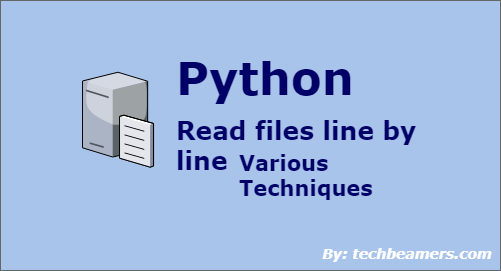Microsoft Flow Read File Content Line by Line
In this tutorial, nosotros'll describe multiple ways in Python to read a file line by line with examples such as using readlines(), context manager, while loops, etc. After this, you can adopt one of these methods in your projects that fits the best as per atmospheric condition.
Python has fabricated File I/O super like shooting fish in a barrel for the programmers. Withal, it is for you to make up one's mind what's the nearly efficient technique for your situation. It would depend on many parameters, such as the frequency of such an functioning, the size of the file, etc.
Let's assume we accept a logs.txt file which resides in the same folder along with the Python script.
Various Techniques to Read a File Line by Line in Python
Contents
- 1 Readlines() to read all lines together
- ane.one Example
- 2 Readline() to read file line by line
- two.1 Example
- iii Reading file using Python context managing director
- 3.1 Example
We'll now go over each of the methods to read a file line past line.

Readlines() to read all lines together
We recommend this solution for files with a smaller size. If the file size is large, then information technology becomes inefficient as information technology loads the entire file in retentiveness.
Nevertheless, when the file is small, it is easier to load and parse the file content line by line.
The readlines() returns a sequence of all lines from the file each containing newline char except the final one.
We've demonstrated the employ of readlines() function in the beneath example. Hither, y'all can see that we are also using the Python while loop to traverse the lines.
Example
""" Example: Using readlines() to read all lines in a file """ ListOfLines = ["Python", "CSharp", "PHP", "JavaScript", "AngularJS"] # Function to create our test file def createFile(): wr = open up("Logs.txt", "w") for line in ListOfLines: # write all lines wr.write(line) wr.write("\n") wr.close() # Office to demo the readlines() role def readFile(): rd = open up ("Logs.txt", "r") # Read listing of lines out = rd.readlines() # Shut file rd.shut() return out # Primary test def master(): # create Logs.txt createFile() # read lines from Logs.txt outList = readFile() # Iterate over the lines for line in outList: print(line.strip()) # Run Test if __name__ == "__main__": main() The output is as follows:
Python CSharp PHP JavaScript AngularJS
On the other hand, the above solution will cause loftier memory usage for large files. So, you should cull a unlike approach.
For instance, you may like to effort this one.
Readline() to read file line by line
When the file size reaches to MBs or in GB, then the right thought is to go 1 line at a time. Python readline() method does this job efficiently. It does non load all data in one become.
The readline() reads the text until the newline graphic symbol and returns the line. It handles the EOF (terminate of file) by returning a blank cord.
Example
""" Instance: Using readline() to read a file line by line in Python """ ListOfLines = ["Tesla", "Ram", "GMC", "Chrysler", "Chevrolet"] # Function to create our test file def createFile(): wr = open("Logs.txt", "due west") for line in ListOfLines: # write all lines wr.write(line) wr.write("\north") wr.shut() # Function to demo the readlines() function def readFile(): rd = open ("Logs.txt", "r") # Read list of lines out = [] # listing to save lines while Truthful: # Read next line line = rd.readline() # If line is blank, then you struck the EOF if not line : break; out.append(line.strip()) # Close file rd.close() return out # Main exam def main(): # create Logs.txt createFile() # read lines from Logs.txt outList = readFile() # Iterate over the lines for line in outList: print(line.strip()) # Run Test if __name__ == "__main__": main() After execution, the output is:
Tesla Ram GMC Chrysler Chevrolet
Reading file using Python context manager
Python provides a concept of context managers. Information technology involves using the "with" clause with the File I/O functions. Information technology keeps track of the open file and closes information technology automatically after the file operation ends.
Hence, we tin can confirm that you never miss endmost a filehandle using the context managing director. It performs cleanup tasks similar closing a file accordingly.
In the beneath instance, you lot can see that we are using the context manager (with) along with the for loop to first write and then reading lines.
Example
""" Example: Using context manager and for loop read a file line past line """ ListOfLines = ["NumPy", "Theano", "Keras", "PyTorch", "SciPy"] # Function to create examination log using context manager def createFile(): with open ("testLog.txt", "w") equally wr: for line in ListOfLines: # write all lines wr.write(line) wr.write("\north") # Office to read test log using context director def readFile(): rd = open up ("testLog.txt", "r") # Read list of lines out = [] # list to salvage lines with open ("testLog.txt", "r") as rd: # Read lines in loop for line in rd: # All lines (likewise the terminal) will include newline, so strip information technology out.suspend(line.strip()) render out # Main examination def main(): # create testLog.txt createFile() # read lines from testLog.txt outList = readFile() # Iterate over the lines for line in outList: print(line.strip()) # Run Test if __name__ == "__main__": principal() After running the code snippet, the output is:
NumPy Theano Keras PyTorch SciPy
To acquire more about File I/O, read our Python file treatment tutorial.
Source: https://www.techbeamers.com/python-read-file-line-by-line/
0 Response to "Microsoft Flow Read File Content Line by Line"
Post a Comment